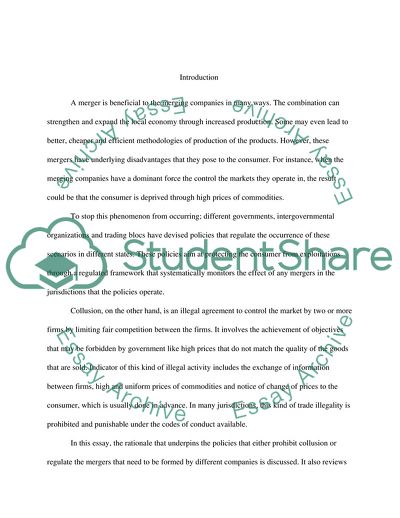Cite this document
(Explain the underlying rationale for policies to control merger and to Essay, n.d.)
Explain the underlying rationale for policies to control merger and to Essay. https://studentshare.org/macro-microeconomics/1848040-explain-the-underlying-rationale-for-policies-to-control-merger-and-to-prevent-collusion-why-do-governments-often-decide-to-regulate-mergers-on-a-case-by-case-basis-but-to-prohibit-collusion-illustrate-your-answer-with-cases-with-which-you-are-famili
Explain the underlying rationale for policies to control merger and to Essay. https://studentshare.org/macro-microeconomics/1848040-explain-the-underlying-rationale-for-policies-to-control-merger-and-to-prevent-collusion-why-do-governments-often-decide-to-regulate-mergers-on-a-case-by-case-basis-but-to-prohibit-collusion-illustrate-your-answer-with-cases-with-which-you-are-famili
(Explain the Underlying Rationale for Policies to Control Merger and to Essay)
Explain the Underlying Rationale for Policies to Control Merger and to Essay. https://studentshare.org/macro-microeconomics/1848040-explain-the-underlying-rationale-for-policies-to-control-merger-and-to-prevent-collusion-why-do-governments-often-decide-to-regulate-mergers-on-a-case-by-case-basis-but-to-prohibit-collusion-illustrate-your-answer-with-cases-with-which-you-are-famili.
Explain the Underlying Rationale for Policies to Control Merger and to Essay. https://studentshare.org/macro-microeconomics/1848040-explain-the-underlying-rationale-for-policies-to-control-merger-and-to-prevent-collusion-why-do-governments-often-decide-to-regulate-mergers-on-a-case-by-case-basis-but-to-prohibit-collusion-illustrate-your-answer-with-cases-with-which-you-are-famili.
“Explain the Underlying Rationale for Policies to Control Merger and to Essay”. https://studentshare.org/macro-microeconomics/1848040-explain-the-underlying-rationale-for-policies-to-control-merger-and-to-prevent-collusion-why-do-governments-often-decide-to-regulate-mergers-on-a-case-by-case-basis-but-to-prohibit-collusion-illustrate-your-answer-with-cases-with-which-you-are-famili.


